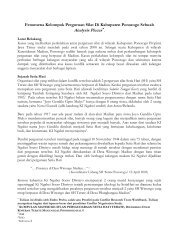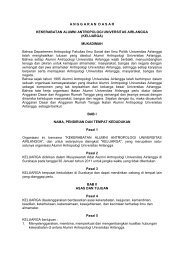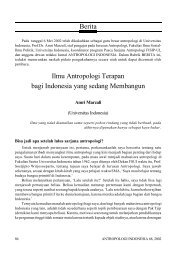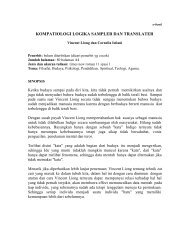The Future of Visual Anthropology: Engaging the Senses
The Future of Visual Anthropology: Engaging the Senses
The Future of Visual Anthropology: Engaging the Senses
Create successful ePaper yourself
Turn your PDF publications into a flip-book with our unique Google optimized e-Paper software.
widijanto judono e-Library collection - widijanto.wordpress.com<br />
<strong>Engaging</strong> <strong>the</strong> visual 7<br />
visual images and technologies. <strong>The</strong> notion <strong>of</strong> an observational anthropology was by<br />
no means coterminous with a visual anthropology. In fact an interrogation <strong>of</strong> <strong>the</strong><br />
work <strong>of</strong> <strong>the</strong> observational method’s two main proponents – Malinowski and Boas –<br />
reveals that, although both were prolific photographers, <strong>the</strong>ir approaches actually<br />
limited <strong>the</strong> potential <strong>of</strong> <strong>the</strong> visual.<br />
Dating from 1883 to 1930, historically Boas’ initial photography pre-dates<br />
Haddon’s expedition. His early work with <strong>the</strong> Kwakiutl Indians, which contributed<br />
to his ‘multimedia approach’ to anthropometric studies (also including measurements<br />
and plaster casts <strong>of</strong> body parts) (Jacknis 1984: 20), has some parallels with<br />
Haddon’s enthusiasm for new technologies. However, later Boas’ interests shifted<br />
and his photographs (<strong>of</strong>ten taken by an indigenous photographer) covered material<br />
culture, ceremonies, temporal and spatial patterning as well as portrait and<br />
physical-type photographs <strong>of</strong> people. <strong>The</strong>y were presented in museum collections,<br />
at his lectures and in two monographs. His use <strong>of</strong> film, mainly to record native<br />
dance, was to combine <strong>the</strong>se materials as a source <strong>of</strong> raw data for triangulation with<br />
o<strong>the</strong>r sources (Griffiths 2002: 306). Although some see Boas as a ‘fa<strong>the</strong>r figure in<br />
visual anthropology’ (Ruby 1980: 7, see Jacknis 1984: 51), Jacknis’ analysis demonstrates<br />
that ‘photography was caught in <strong>the</strong> inherent contradiction that defined<br />
Boas’ fieldwork’ (1984: 47). Boas believed culture could only be understood historically<br />
and he moreover mistrusted <strong>the</strong> visual because it only showed <strong>the</strong> surface. For<br />
Boas ‘<strong>the</strong> study <strong>of</strong> <strong>the</strong> human mind was possible only through <strong>the</strong> medium <strong>of</strong><br />
language’, thus ‘<strong>the</strong> mere act <strong>of</strong> witnessing some exotic behaviour was insufficient’<br />
(Jacknis 1984: 44). As such his approach foiled and did not promote any anthropological<br />
appreciation <strong>of</strong> <strong>the</strong> scientific value <strong>of</strong> photography. He created a legacy for<br />
his students (such as Margaret Mead), who later followed his example <strong>of</strong> using<br />
visual media, a context where <strong>the</strong> visual image was not valued. 13<br />
Malinowski was also an active fieldwork photographer (about 1,100 <strong>of</strong> his images<br />
are archived at <strong>the</strong> London School <strong>of</strong> Economics (Young 1998: 21)). He rejected<br />
<strong>the</strong> principles <strong>of</strong> <strong>the</strong> anthropometric photography <strong>of</strong> <strong>the</strong> nineteenth century to<br />
create a photographic record <strong>of</strong> ‘living’ people (Young 1998: 4), using photography<br />
extensively in his publications (1998: 21). However, while his photography was<br />
prolific (and influenced later visual practices), it was fundamentally incompatible<br />
with <strong>the</strong> fieldwork experience Malinowski advocated. In Grimshaw’s interpretation<br />
Malinowski’s fieldwork methodology was based in romanticism, it relied on<br />
‘<strong>the</strong> cultivation <strong>of</strong> human sensibility or passion’, and repudiated ‘technology,<br />
mechanical skill and <strong>the</strong> trappings <strong>of</strong> industrial civilisation’ (Grimshaw 2001: 54).<br />
Likewise, his writing was ‘painterly’ ra<strong>the</strong>r than cinematic, relying on literary<br />
composition ra<strong>the</strong>r than montage (2001: 55–6). Grimshaw shows how<br />
Malinowski’s observational approach employed experience and description to<br />
create a picture <strong>of</strong> a ‘whole’ society or context. <strong>The</strong> mediation <strong>of</strong> technology and<br />
specificity <strong>of</strong> photography constituted a contradiction in this work, and his wider<br />
approach left little room for visual methodology. Jacknis’ and Grimshaw’s respective<br />
analyses <strong>of</strong> <strong>the</strong> legacies <strong>of</strong> Boas and Malinowski suggest that although participant<br />
observation became a requirement for anthropological fieldwork, it is










